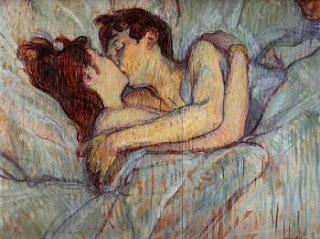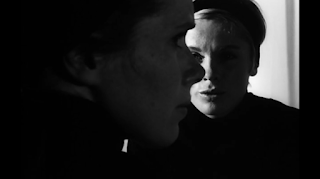Closure.
Art and Film.
Two Figures (2): Closure.
 |
| Illustration 1: 'Exotica', 1994, film; Atom Egoyan, director; Paul Sarossy, cinematographer; Mia Kirshner, actress; Bruce Greenwood, actor. |
A striptease artist presses herself against the body of an obsessive, estranged customer: 'He's a very particular case ... [she says] ... he's just so fucked up!'. Her encroachment into the right half of the frame leaves a gap (left) where the performer and object of male fantasy should be [compare Illustration 2]:
 |
| Illustration 2: 'We've always had this understanding ... I need him for certain things, and he needs me'. |
Their overlapping silhouettes (Illustration 1) combine in a closure effect, that seems to encapsulate the intense emotional consonance of these two damaged characters.
 |
| Illustration 3: 'In Bed, The Kiss', 1892, painting; Henri De Toulouse-Lautrec. |
A separation of lights (bodies and bedding) and darks (hair and contours), in this painting, is unified by the technique of closure; with line providing sufficient cues to maintain a coherent representation. The embracing women have been reduced to a simplified visual pattern that suggests the merging of each individual within a greater, near-abstract whole.
 |
| Illustration 4. |
Illustration 4 (A - left and right) demonstrates the method of closure: an incomplete pictorial arrangement contains just enough order for the brain to construct an image. The fragility of this approach becomes apparent when the pictures are viewed upside down (Illustration 4, B - left and right): they are now entirely abstract. This ambiguity between figurative and non-figurative modes was described by John Russell (on Francis Bacon) as 'to be and not to be'.
 |
| Illustration 5: 'Persona', film, 1966; Ingmar Bergman, director; Sven Nykvist, cinematographer; Liv Ullmann, actress; Bibi Andersson, actress. |
In Illustration 5, closure elements - discrete whites and blacks, with grey half-tones - give a face (right) the appearance of a Rorschach blotting. Is Bergman using abstraction as a symbol for two psyches in harmony? Or is he pointing to a dangerous interpenetration of very different personalities?
 |
| Illustration 6: 'The Kiss', 1897, painting; Edvard Munch. |
Munch similarly depicts the blending of human profiles, making a composite silhouette that seems isolated against its background. Individual features are obscured, both bodies becoming one mass. Whereas Lautrec (in Illustration 3) creates an amalgamation of female forms, 'The Kiss', 1897, explores the absorption of the masculine inside the feminine: a sublimation of multiple anxieties that recur throughout this artist's oeuvre; a fear of isolation, of the loss of self and of abandonment.
'I felt as if there were invisible threads connecting us. I felt the invisible strands of her hair still winding around me; and thus as she disappeared completely ... I still felt it, felt the pain ... because the threads could not be severed' - Edvard Munch.



Comments
Post a Comment